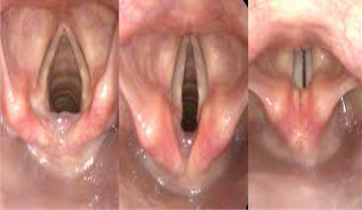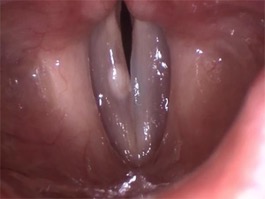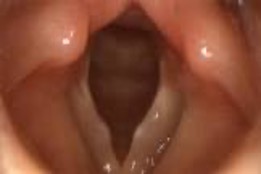Diseases Of The Larynx
Changes in the function or structure of the vocal folds, even if very subtle, can lead to vocal hoarseness; there are many causes of a hoarse voice. Most commonly, hoarseness occurs because of a viral infection (viral laryngitis) or inflammation in the vocal tract. Inflammation can occurs due to many causes, most commonly gastroesphageal reflux disease or nasal allergies with post-nasal drip. Even a tiny amount of inflammatory swelling (‘oedema’) of the vocal fold surface can cause significant vocal hoarseness, especially for a singer or professional voice user.
Growths on the free edges of the vocal folds usually causes significant hoarseness. This hoarseness is frequently present when speaking and singing and can impact on day to day functioning. Different growths have different names depending on their appearance, structure and where they are located. Some examples of common benign (non-cancerous) vocal fold lesions are shown below.
Vocal fold polyps
A vocal cord polyp occurs just below the surface of the vocal fold. Vocal polyps are thought to occur due to ‘phonotrauma’, aka voice overuse / abuse. They usually occur at the junction of the front third and back two thirds of the vocal fold, at the point of maximal vibration amplitude during speaking, yelling and singing. Polyps often require surgical removal and voice therapy before and after any surgery is essential to improve voice use patterns and minimize scar tissue formation.
Vocal fold cysts
Vocal fold cysts sit deep to the surface lining of the vocal fold. They can cause hoarseness by preventing the vocal folds from closing properly and decreasing their ability to vibrate during speaking / singing. Most cysts form due to phonotrauma. Surgery is often required to remove the cyst as they rarely resolve spontaneously.
Vocal fold nodules ('Singer's nodes")
Whereas polyps and cysts usually occur on one side only, vocal cord nodules form along the mid-portions of the vocal folds on both sides. The size and consistency of the nodules contribute to the degree of hoarseness observed with this diagnosis. Nodules prevent the vocal folds closing properly and reduce the ability of the folds to vibrate during voicing. They are usually managed with voice therapy to try and lessen the impact of vocal fold closure on the nodules. Failure to improve with voice therapy may rarely necessitate surgical removal direct steroid injection into the nodules.
Vocal fold papillomas
Vocal fold papillomas are warty growths on the vocal folds. Papillomas occur due to infection with human papillomavirus. The lesions can vary from a single lesion to multiple lesions and will often return after surgical removal, necessitating repeat procedures. Papillomas are usually non-cancerous although occasionally precancerous cell changes can be seen within the papilloma.
Vocal fold dysplasia and carcinoma
Vocal fold dysplasia refers to abnormal, atypical cells within a given vocal fold lesion. The degree of cell atypia can range from mild to severe. Severe vocal fold dysplasia is a pre-cancerous lesion and, if left untreated, can progress to cancer (carcinoma). Vocal fold cancers often present early due to their significant effects on voice at an early stage in their evolution. Smoking is the main risk factor for cancer of the larynx however non-smokers can also get this disease. If you have hoarseness that does not resolve within four weeks, you should see your GP for a referral to a laryngologist to look at your voice box.



